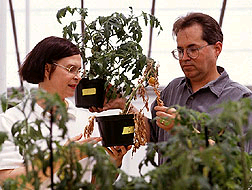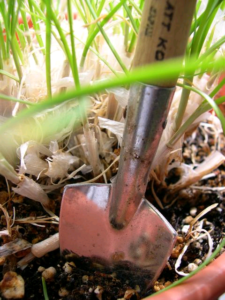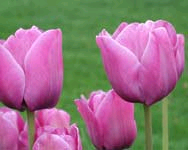Although testing and amending the soil give gardeners a sense of accomplishment, the reason behind all of that work was to grow beautiful, fragrant, delicious plants. Choose your plants wisely and plant them carefully, and they’ll give you joy for years.
Once you’ve tested and improved your soil, you’ll be able to plant your garden. What you plant will depend on your personal style and your reasons for gardening. If you want a beautiful, shady nook in your backyard, then you’ll plant trees and shrubs, including plenty of flowers and foliage. If you want to eat what you grow, you might be considering a vegetable garden or a fruit orchard. Regardless of your motivation, your garden will be more successful and require less maintenance if you choose disease-resistant or native plants.

Choose Disease-Resistant Varieties – Disease-resistant plant varieties are one of an organic gardener’s best tricks for reducing the need for toxic chemicals in the garden. Disease resistance refers to a cultivar’s level of susceptibility to one or more specific diseases. For instance, if you live in an area where your neighbors’ tomato plants wilt from the top down and produce few tomatoes, you’ll want to choose tomato plants that are resistant to fusarium wilt.
When you choose disease-resistant cultivars, remember that no plant is entirely immune to a specific disease. Resistance is best described as a continuum, with some plants being more susceptible than others. Also, know that even the most resistant plants are only resistant to the disease or diseases listed. A plant that is resistant to one disease is still susceptible to others.
Choose Native Varieties – Native plant species are varieties that grow naturally in your area. Because they’ve grown in your area for hundreds of years, native species are well adapted to your soil and weather conditions, as well as common insects and plant diseases. There’s another benefit, too. By planting native species, you’re giving homes to the native birds and butterflies that love them.
Sowing your Seeds
Finally, the day you’ve been waiting for. It’s time to plant your tiny seeds or leafy little plants into your carefully amended soil. By now you’ve tested your soil and added organic matter to increase the available nutrients, add structure, and improve drainage. All you need to do now is complete your final preparations and watch your garden grow.
Preparing the Site
Every spring, you see farmers out in the fields, turning over their ground with plows attached to their tractors. One neighbor might drag his tiller out of the shed to turn over his annuals bed, while another gets out her shovel and starts turning the ground over by hand. As an organic gardener, you’ll want to join your neighbors in turning over the first few inches of topsoil in the spring, adding in some compost or your green manure crop. You will need a few tools, and you’ll need to allow your soil to rest for a week or two before you plant.
Tools You’ll Need – The tools you use to prepare your planting site and put your plants in the ground can make a big difference in the amount of work you have to do and the health of your soil. Every gardener needs to have a few, good-quality tools.
A shovel – When you choose a shovel for your garden, choose a high-quality, forged-steel shovel with a  fiberglass handle. Your shovel is the biggest workhorse in your garden, and you will use it to dig, scoop, slash, and break up chunks.
fiberglass handle. Your shovel is the biggest workhorse in your garden, and you will use it to dig, scoop, slash, and break up chunks.
A trowel – When you want to work close to your plants or transplant seedlings, a full-sized shovel will be too big and awkward. A small hand trowel will do the job marvelously.
A stiff-tined rake – Don’t step on it, or this rake will fly up and hit you in the face. That’s no reason not to buy one, though–a garden rake is great at smoothing out soil, filtering out small stones, and covering new seeds with earth. It can also help you spread organic material or level your soil.
Gloves – A good pair of gardening gloves is a must. Fertile soil contains many bacteria that are harmless, or even beneficial, to plants, but that can make humans very sick. Gloves will keep your hands clean and healthy.
NOT a tiller – When your neighbor uses a tiller on his garden plot, he’s destroying the fungi chains that help plants’ roots take in nutrients. If you’re breaking up sod for a new garden, then a tiller is immensely helpful. Take the tiller back to the rental depot afterwards, though, or your soil will loose a lot of the structure and biological diversity you’ve worked to hard to create.
Resting Time – After you’ve prepared your soil by turning it over with a shovel and using your rake to mix in organic material, walk away from your garden for a week or two before you plant. You want your soil to have time to rest, so that earthworms can dig tunnels, the soil can settle, and the nutrients can become more available to plant roots.
When to Plant
After you’ve turned over your soil and let it rest, your soil is ready to receive plants. If you want your plants to thrive, plant them during the right time of year and at the right time of day for the particular plants that you’re growing.
Time of Year – The best time of year to plant varies, depending on the type and species of plant you’re growing. A nursery specialist will be able to give you specific planting advice, although some general principles will help you decide during which season you should head to the nursery.
Trees – In temperate climates, most trees grow best when planted during the fall. Fall planting gives trees a chance to get established before spring droughts. But don’t feel like you missed your chance if you realize that it’s December and you haven’t planted yet– as long as the weather isn’t too frosty or windy, a hardy tree will do fine if planted in early winter.
 Bulbs – Bulbs are always popular with gardeners because they require very little maintenance and come back each year. You will need to plant them at the right time of year, though. Plant spring-flowering bulbs, such as crocuses and daffodils, in early fall. You should plant summer-flowering bulbs, like gladiolas, in the spring.
Bulbs – Bulbs are always popular with gardeners because they require very little maintenance and come back each year. You will need to plant them at the right time of year, though. Plant spring-flowering bulbs, such as crocuses and daffodils, in early fall. You should plant summer-flowering bulbs, like gladiolas, in the spring.
Shrubs – Deciduous shrubs and hedges can be planted during a wide variety of seasonal conditions. You can plant container-grown shrubs at any time of year, and bare-root shrubs during any month from October to March. To give your shrubs the best chance of survival, though, plant them in November. The ground will be workable, and there will be little chance of drought.
Vegetables – The wide variety of vegetables, different conditions they prefer, and different ripening times make it impossible to give a generalized best planting time for vegetables. For a detailed list of different vegetables and their ideal growing conditions, visit the appendix.
Time of Day – A lot of people get so excited about working in their gardens that they rush out in the morning of the first warm day of spring and plant their tender new seedlings. By the afternoon, the plants have withered, and they never become hardy members of the garden. To give your plantlets time to adapt to the soil before they are tested by the bright sun, put them in the ground on a day that is warm but drizzling, or in the afternoon of a sunny day that will turn into a mild night. Hardier plants, like trees and shrubs, will also benefit from being planted in less than full sun. If they are able to start taking in nutrients and water from the soil before the sunshine tests their leaves, they will be more likely to do well in your garden.